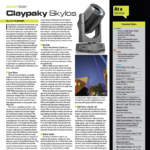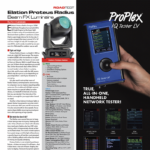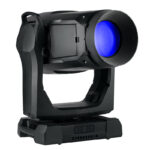Today, we’re looking at the IP54 Light Sky AquaBeam from SHS Global. Originally known as a used gear company, SHS has since expanded their operations into distributing various lines, including the AquaBeam from Light Sky, an IP rated moving head beam projector with a lot of power. There’s still a solid place for arc-based lights in the industry; LEDs still don’t have the raw output needed for certain applications. Extremely short-arc lamps like the one found in the AquaBeam pack a tremendous punch for low wattage, which makes them very attractive for this class of narrow-beam moving heads.
The AquaBeam comes in a fairly conventional plastic housing, with a large 6.75-inch diameter output lens. The base measures 11.8 by 15.3 inches, while the head stands 23.7 inches high. There are handles on either side for easy handling, and the whole fixture weighs a very reasonable 51 pounds. The lamp is an Osram Sirius HRI 440W short-arc lamp, which is accessed by first removing six captive hex screws from the rear of the light and removing the back cover, then removing the main lamp cooling fan. (These cover screws are deeply recessed, so having a slender screwdriver will help a lot here.) This process is not something I would attempt while the light is hanging in the rig.
Dimming and Output
The output of this light is, simply, impressive. I set the fixture up on my front porch at night and shone it down the block, and even without haze in the air the light cut an impressive beam through the air outside, easily visible several blocks away. With haze, the effect is even more impressive. I imagine this light will be quite effective on outdoor lighting rigs where we sometimes struggle to keep smoke on the stage. With or without haze, this beam punches.
Most of the light’s components lie on a single removable module. It is rather labor-intensive to take this module out of the head — it requires the removal of the rear head cover, lamp and several Molex-style connectors from two small circuit boards. Opening this unit is definitely a job to do when the fixture is out of the rig on a workbench, not hanging in the air, but that is to be expected. Weatherproofing fixtures introduces trade-offs — all those mechanical seals to keep water out have to be opened before you can service the fixture and take more time than most non-IP-rated lights. The benefit, of course, is that water and dust exposure on outdoor shows is no longer a concern. Immediately after the angled hot mirror on this module is the color-mix system, which itself lies on the main module at an angle to help direct heat away from the sensitive internal parts.
The fixed color system, dimmer and color-mix system all occupy the same module. This is where things get slightly unusual, as the color-mix glass occupies only half of each wheel; the other half of each is empty (except for the cyan wheel). Located in the other half of the cyan wheel is a mechanical metal dimmer with long metal slits that start large and gradually taper down to dim the light. More on that later. Also on this module is an eleven-slot plus open fixed color wheel with non-replaceable filters. Gaps between adjacent colors are very small, but split colors are a touch difficult to accomplish, as the color wheel jumps between values instead of smoothly indexing and doesn’t always land “cleanly” on a color split. The second half of the fixed color wheel channel spins the entire wheel.
Color mixing this class of extremely-narrow beam lights is very difficult. The AquaBeam exhibits minor artifacts across its color mixing range, but the finely stippled pattern on the wheels do quite a good job of keeping them to acceptable levels, even with the very narrow beam and move reasonably fast.
Dimming is accomplished via a small flag further up on this module, or optionally, via the dimmer on the cyan flag. The primary dimmer exhibits a slightly “compressed” law similar to what we’ve seen with other extremely narrow-beam fixtures, with the majority of the dimming happening between 50 and 80 percent and exhibits significant vignetting as the flag moves in from one side to cover the beam. (This is not something I expect will be an issue in this light’s intended usage context.) This flag is also used to produce the strobe effects. The second dimmer on the cyan wheel can be accessed through a DMX channel. This secondary dimmer has a more conventional tooth-like pattern and provides smoother dimming that more closely follows a square “incandescent” law. The cyan wheel is unavailable in this mode, but the magenta and yellow wheels can still be used.
Gobos and Prisms
This module also houses the fixed gobo wheel, which is a single stamped metal wheel with twelve fixed (non-replaceable) gobos plus open. These are patterns familiar to this class of lights, including aperture reducers, dots, stars and an animation pattern. Changes between adjacent patterns are extremely fast, almost invisible. The focus point of the beam is almost 15 feet out in front of the lens, which gives an interesting focus effect in mid-air, especially when haze is present. The fact that there is a focus channel for a beam fixture like this is great for fine tuning the sharpness of the breakup. It moves pretty slowly as one adjusts it.
Further downstream are the twin prisms, which are controlled by the same channel on the light and cannot be overlaid. These consist of a twenty-four-facet circular prism and a six-facet linear prism. Both can be rotated at variable speeds and provide good image separation with acceptable levels of fall-off toward the edges. The prisms take about 0.2 seconds to insert or remove from the beam. Also close by is the frost flag, which increases the beam angle from 2° to 45° and provides a heavy frost for wash effects. The frost inserts very quickly, fast enough to use an effect, and it is variable across the entire range. A full frost will nullify any gobo or prism images.
The fixture is moderately well-behaved on reset, snapping the shutter closed to home and only re-opening it when it’s back into position. Homing from both cold and warm starts took 25 seconds. The pan and tilt range are 540° and 250°, respectively, and the fixture covers its ranges in pan range in 3 seconds and its tilt in 1.7 seconds. A feature that I particularly like is the integrated rigging: there are two permanently-attached hanging hooks on the base of the fixture which can fold to lay flat when using the light on a floor. It’s hard to overstate the convenience of this feature — it allows the user to store the fixtures in a low-profile box and very quickly deploy the fixtures without having to worry about workers attaching the rigging hardware incorrectly. It also saves time. It’s important to note that no accommodations for other rigging hardware are made; this is to prevent water ingress in keeping with the IP54 rating.
Power input is via a Neutrik powerCON TRUE1 connector and pulls 628 watts at full tilt. DMX in is via 5-pin in and throughs, or optionally via a built-in WDMX 2.4Ghz receiver. The fixture is IP54 rated, sealed against moisture and dust, and all the external inputs have rubber gaskets over them to help with this. Fixture settings and modes are set via a full-color menu on the front of the fixture, and it weighs in at 51.8lbs.
The AquaBeam is an interesting addition to the world of extreme-output fixtures, with a solid feature set and outdoor rating that should make it attractive to festivals and concerts of all types.
At a Glance
Bright, Efficient and IP-Rated
LED light sources aren’t the only option for those seeking to combine brightness with efficiency; extremely short-arc lamps are more efficient than their incandescent predecessors, and the TourPro LightSky AquaBeam from SHS combines relatively low wattage with tremendous punch. It’s also IP-54 rated for outdoor use, and despite a few minor quirks, this fixture provides designers with most of the color-mixing and gobo options they’re likely to need for a wide range of outdoor festivals and concert applications.
TourPro LightSky AquaBeam
PROS: Extremely bright, weatherproof, integrated rigging hardware
CONS: Split colors are difficult.
FEATURES:
- IP Rating: IP54
- Lamp: Osram Sirius HRI 440s
- Lamp Life: 1,200 hours
- Optics: 16 facet +32 facet (standard); 3 facet +8 facet (optional)
- Dimmer: 0-100% linear
- Shutter/Fading Effects: Independent, with adjustable speed
- Strobe: Mechanical, .5-20 flash per second with random strobe effect
- Color Mixing: Color wheel with 6 dichroic filters + open (linear-step-less selection); CMY color mixing
- White Color Temperatures: 3200K to 7800K
STATS:
- Size: 11.8 x 15.3 x 23.7”
- Weight: 51 pounds
- Power: 628 watts
- MSRP: $3,499
- Manufacturer: TourPro Lighting
- Distributor: SHS Global
- More Info: www.tourprolighting.com, www.shsglobal.com



